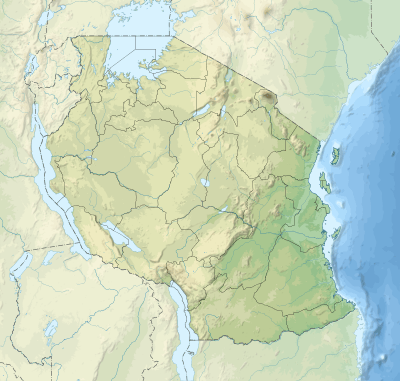Hale Dam
| Hale Dam | |
|---|---|
 Map of Tanzania showing the location of Hale Dam | |
| Official name | Hale Power Station |
| Location | Hale, Tanga, Tanzania |
| Coordinates | 05°17′53.3″S 38°36′14.8″E / 5.298139°S 38.604111°ECoordinates: 05°17′53.3″S 38°36′14.8″E / 5.298139°S 38.604111°E |
| Construction began | 1961 |
| Opening date | 1964 |
| Construction cost | £5,000,000 (1964) |
| Owner(s) | TANESCO |
| Dam and spillways | |
| Impounds | Pangani River |
| Spillway type | Earth and Rock Fill |
| Spillway capacity | 1,190 m3 (0.96 acre·ft) |
| Power station | |
| Operator(s) | Tanesco |
| Commission date | 1964 |
| Turbines | 2x10.5 |
| Installed capacity | 21 MW (28,000 hp) |
Hale Dam is a hydroelectric dam in Tanzania, located in the Tanga Region. Its installed capacity is 21 megawatts (28,000 hp). Thousands of people were displaced to build the dam.
History
The Hale Dam is the oldest operation dam currently in the country. The Pangani river basin had been a source of power since the early colonial times for Tanganiyka. The lower Pangani power plant was established at Pangani Falls by a German company as early as 1936. With the growing Tanga region and the close proximity to Mombasa, the government decided to construct a new Hydro electric power plant in Hale.[1]
The plant began construction in 1961 and cost around £5,000,000, which was the single largest investment into the country since the failed groundnut scheme.[1] The power-plant became operational in November 1964.[2]
Overview
The Hale hydro electric Power Plant utilizes a natural fall of 70 meters. It is sited at Hale Township on the Segera–Tanga highway, 6 km from the Tanga – Moshi junction at Segera.[2]
Water from the neighboring rivers is channeled and dropped 70 meters below the ground surface. The power-plant its self is based 76 meters below the surface. The underground power station generates power by two vertical units comprising Francis turbines and salient pole generators and has an installed capacity of 21 MW (28,000 hp).[2]
The plant has undergone heavy rehabilitation twice since its inauguration, in 1987 and 2009.[2]
The construction of the dam in the 1960s led to the displacement of about 12,000 people. However, after the establishment of the dam, with a big supply of water and fish, it attracted a large proportion of migrants from fishing communities. This has also led to the establishment of big urban settlements called Nyumba ya Mungu, with an estimated population of about 20,000 people in 2002. The growing population led to a lot of water conflicts.[3]
See also
References
- 1 2 Datoo, B.A. (April 1965). "The generation of hydro-electric power on the lower Pangani river" (PDF). East African Geographical Review. 3: 47–49. Retrieved 29 July 2015.
- 1 2 3 4 "Pangani Hydro Systems". TANESCO. Tanesco. Retrieved 29 July 2015.
- ↑ Mbonile, Milline J. (March 2005). "Migration and intensification of water conflicts in the Pangani Basin, Tanzania". Habitat International. 29 (1): 41–67. doi:10.1016/s0197-3975(03)00061-4. Retrieved 29 July 2015.
External links
- Tanesco Website